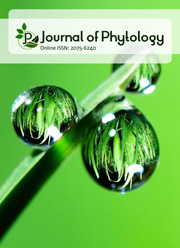Studies on carbon sequestration potential of trees with epiphytic orchid association
DOI:
https://doi.org/10.25081/cb.2025.v16.9257Keywords:
Epiphytic orchids, Carbon storage in trees, Carbon storage capacity of epiphytes, Mitigating climate change via floraAbstract
Epiphytic orchids are a fascinating group of plant species that thrive on the branches and trunks of trees, forming intricate symbiotic relationships with their host. They contribute to the vibrant biodiversity of forest ecosystems and play a crucial role in carbon dynamics and storage. The study aims to estimate carbon sequestrations of phorophytes and associated epiphytic orchids by quantifying the above ground biomass (AGB), total biomass (TB), and amount of carbon stored. It has been found that 97 trees from nine different tree species are associated with epiphytes in the study area. Among the nine species examined, Alstonia scholaris exhibited the highest biomass for above ground, below ground, and total biomass, with values of 24,043.35 kg/tree, 6,251.27 kg/tree, and 30,294.62 kg/tree, respectively. In addition, Cocos nucifera had the lowest values. The highest biomass, carbon storage, and rate of carbon sequestration were recorded for the epiphyte species associated with the phorophyte A. scholaris. When the phorophytes were associated with epiphytic orchids, their carbon sequestration rates rose from 1.94% to 15.07%. This study provides empirical evidence and analytical perspectives to create a model that mitigates the consequences of climate change and global warming while maintaining current land usage.
Downloads
References
Adiaha, M. S., Buba, A. H., Tangban, E. E., & Okpoho, A. N. (2020). Mitigating Global Greenhouse Gas Emission: The Role of Trees as a Clean Mechanism for CO2 Sequestration. The Journal of Agricultural Sciences - Sri Lanka, 15(1), 101-115. https://doi.org/10.4038/jas.v15i1.8675
Asfaw, Z., & Zergaw, Y. (2022). Woody Species Diversity and Biomass Carbon Sequestration in Private Residential Green Infrastructure of Dilla Town, Southern Ethiopia. International Journal of Forestry Research, 2022, 017094. https://doi.org/10.1155/2022/4017094
Cairns, M. A., Brown, S., Helmer, E. H., & Baumgardner, G. A. (1997). Root biomass allocation in the world's upland forests. Oecologia, 111(1), 1-11. https://doi.org/10.1007/s004420050201
Cedric, C. D., Nfornkah, B. N., Louis-Paul-Roger, K. B., Claire, N. J., Christian, M. A., Bruno, T. M. R., Forje, G. W., Nadege, M. T., Flore, N. Y. A., Hubert, M. K., Mireil, T. V., & Louis, Z. (2021). Orchid Diversity and Biomass on a Native Host Tree Species in a Semi-deciduous Rain Forest of Cameroon. Journal of Sustainable Forestry, 40(2), 142-153. https://doi.org/10.1080/10549811.2020.1746350
Domke, G. M., Oswalt, S. N., Walters, B. F., & Morin, R. S. (2020). Tree planting has the potential to increase carbon sequestration capacity of forests in the United States. Proceedings of the National Academy of Sciences, 117(40), 24649-24651. https://doi.org/10.1073/pnas.2010840117
Dugaya, D., Srirag, S., Pandey, A. K., Paul, A., Shukla, D. D., Deo, K., Sharma, N., Verma, S., Nagaria, S., Guhaprasad, S. & Chaudhry, P. (2020). Carbon sequestration potential of trees planted along roadsides: a case from Bhopal City, India. International Journal of Environment, 9(2), 104-119. https://doi.org/10.3126/ije.v9i2.32537
Enríquez‐de‐Salamanca, Á. (2024). Environmental and social impacts of carbon sequestration. Integrated Environmental Assessment and Management, 20(6), 1812-1838. https://doi.org/10.1002/ieam.4925
Houghton, R. A. (2002). Terrestrial carbon sinks–uncertain. Biologist, 49(4), 155-160.
Lahoti, S., Lahoti, A., Joshi, R. K., & Saito, O. (2020). Vegetation structure, species composition, and carbon sink potential of urban green spaces in Nagpur City, India. Land, 9(4), 107. https://doi.org/10.3390/land9040107
Liu, K., Wang, J., Zeng, W., & Song, J. (2017). Comparison and evaluation of three methods for estimating forest above ground biomass using TM and GLAS data. Remote Sensing, 9(4), 341. https://doi.org/10.3390/rs9040341
Martínez-Meléndez, N., Ramírez-Marcial, N., García-Franco, J. G., Cach-Pérez, M. J., & Martínez-Zurimendi, P. (2022). Importance of Quercus spp. for diversity and biomass of vascular epiphytes in a managed pine-oak forest in Southern Mexico. Forest Ecosystems, 9, 100034. https://doi.org/10.1016/j.fecs.2022.100034
Morales-Linares, J., García-Franco, J. G., Flores-Palacios, A., Valenzuela-González, J. E., Mata-Rosas, M., & Díaz-Castelazo, C. (2016). Vascular epiphytes and host trees of ant-gardens in an anthropic landscape in southeastern Mexico. The Science of Nature, 103, 96. https://doi.org/10.1007/s00114-016-1421-9
Mulatu, K. (2019). Urban homegarden for woody species conservation and carbon sequestration: the case of Jimma city, Southwest Ethiopia. Journal of Natural Sciences Research, 9(13), 20-31. https://doi.org/10.7176/JNSR/9-13-02
Návar, J. (2009). Allometric equations for tree species and carbon stocks for forests of northwestern Mexico. Forest Ecology and Management, 257(2), 427-434. https://doi.org/10.1016/j.foreco.2008.09.028
Nfornkah, B. N., Zapfack, L., Tchamba, M., Chimi, C. D., & Sonke, B. (2018). A protocol to estimate epiphyte biomass in a forest management unit: case of Cameroon. Journal of Sustainable Forestry, 37(1), 1-13. https://doi.org/10.1080/10549811.2018.1449122
Salimon, C. I., Putz, F. E., Menezes-Filho, L., Anderson, A., Silveira, M., Brown, I. F., & Oliveira, L. C. (2011). Estimating state-wide biomass carbon stocks for a REDD plan in Acre, Brazil. Forest Ecology and Management, 262(3), 555-560. https://doi.org/10.1016/j.foreco.2011.04.025
Sedjo, R., & Sohngen, B. (2012). Carbon sequestration in forests and soils. Annual Review of Resource Economics, 4,127-144. https://doi.org/10.1146/annurev-resource-083110-115941
Sharma, S., Hussain, S., Kumar, P., & Singh, A. N. (2024). Urban trees’ potential for regulatory services in the urban environment: an exploration of carbon sequestration. Environmental Monitoring and Assessment, 196, 504. https://doi.org/10.1007/s10661-024-12634-x
Sheikh, A. Q., Skinder, B. M., Pandit, A. K., & Ganai, B. A. (2014). Terrestrial carbon sequestration as a climate change mitigation activity. Journal of Pollution Effects and Control, 2(1), 1000110.
Sheikh, M. A., Kumar, M., Bussmann, R, W., & Todaria, N. P. (2011). Forest carbon stocks and fluxes in physiographic zones of India. Carbon Balance and Management, 6, 15.
Vishnu, R. P., & Patil, S. S. (2016). Carbon Storage and Sequestration by Trees in and Around University Campus of Aurangabad City, Maharashtra. International Journal of Innovative Research in Science, Engineering and Technology, 5(4), 5459-5468.
Zhuang, Q., Shao, Z., Li, D., Huang, X., Li, Y., Altan, O., & Wu, S. (2023). Impact of global urban expansion on the terrestrial vegetation carbon sequestration capacity. Science of the Total Environment, 879, 163074. https://doi.org/10.1016/j.scitotenv.2023.163074
Published
How to Cite
Issue
Section
Copyright (c) 2025 A. S. Deepthi, Nisha Joseph, Rogimon P. Thomas, Preetha Karnaver, Maria Susan Binu

This work is licensed under a Creative Commons Attribution-NonCommercial 3.0 Unported License.



 .
.